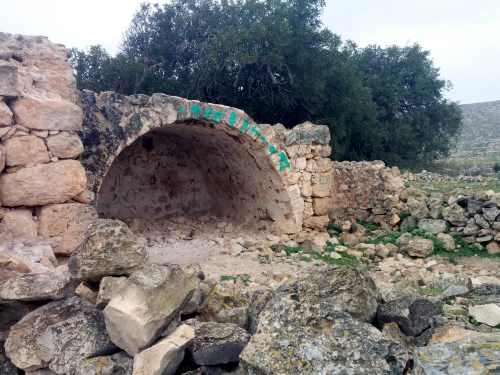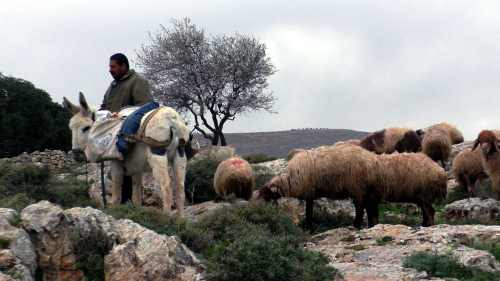Maqam
The road is blocked by a temporary barrier, forcing us to make a long detour to reach the small, 300-inhabitants village. What reason could there be for the arbitrary closure ? There’s no one to ask.
? There’s no one to ask.
Yanun lies among olive groves on a broad rise. The settlement of Itamar is visible on the ridge above. Variously named neighborhoods extend from it along the ridge: Gid’onim A, B, C and Havvat Olam, all illegal outposts. According to the Mapa website, “the village sits on a site dating to the period of the monarchy and to the Romans. Some identify it as the biblical Yanuah (Joshua 16:6-7), and the Yahuah mentioned by Eusebius. The existing locality was established in 1880 by members of the Bosnian Bushnaq family, who left their land after Bosnia came under Austrian rule in 1887.”
A., from Deir el Hattab, accompanies us to the village to show us the ancient maqam, known as Nabi Yanun, located on the hilltop. We reached the road to Yanun after a long detour through Huwwara and Awarta, a journey made longer by the checkpoint erected before Awwarta in the direction we were travelling. We were forced to turn back and drive around.
On the road up the hill to the maqam we met a shepherd with a few sheep. He said he’d been grazing them on the hillside but the settlers chased him away, toward the maqam. He said they come daily. We entered the maqam. We were surprised to be met by a wave of heat, in contrast to the cold outside. We sought the heat’s source. On one side of the room, which wasn’t very big, a deep pit was accessible from which steam rose. Perhaps it reaches hot springs deep in the earth. The natural heating excited us, and A. even more, who was happy to discover such an unusual site near his home.

Apparently the site has been declared a nature preserve by the Israeli authorities. The identification number in Hebrew, ‘Ayin 78, makes this manifest, but like other sites the maqam hasn’t been restored and isn’t maintained. Who’s supposed to restore it when it’s located in Area C and categorized as a nature preserve? A., from Deir el Hattab, offered to ask the Palestinian Authority. When the subject arose of traditional village tools A. said there’s a large courtyard in Deir el Hattab where many tools have been collected. Everywhere we’ve mentioned the topic it turns out there’s already a local initiative we should learn about. Cf. Rachel and Rikki’s recent report from 23.2.17 on Asira a-Shamaliyya.
On our way back we met Palestinians plowing their land in a nearby grove. It’s plowing season. Grain is being sown on some of the plowed area. They told us the plowing also keeps the earth from being swept away by the heavy rains. Suddenly a military vehicle approached with a male and a female soldier. Politely, smiling, they asked what we’re doing here. We asked them the same question. They work in the Civil Administration and travel around the area to protect the inhabitants. We weren’t sure whether they meant the settlers or the Palestinians. Nurit told them about the harassment of the shepherd and asked whom she should contact. They recommended he report it to the Palestinian police who will contact the DCL.
and travel around the area to protect the inhabitants. We weren’t sure whether they meant the settlers or the Palestinians. Nurit told them about the harassment of the shepherd and asked whom she should contact. They recommended he report it to the Palestinian police who will contact the DCL.

